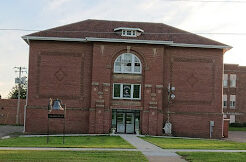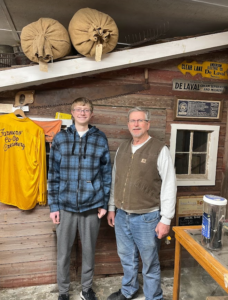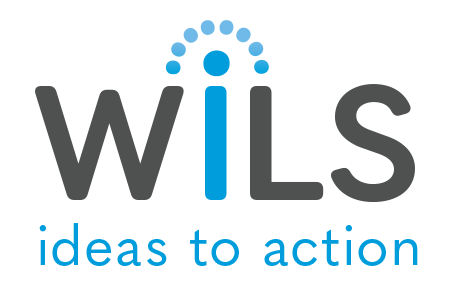
This update on this WiLS 2023 Ideas to Action Fund project, Bringing Our History to Life, is provided by Marci Meyer, Clear Lake School District Librarian.

“We have such a great museum but nobody knows what’s in there.” That is what went through my mind when I decided to apply for the WiLS Ideas to Action Grant. Our Clear Lake Museum is so rich in history that our students and community members should have the opportunity to learn about what it has to offer. Our new display, called Bringing Our History to Life, is a traveling exhibit that showcases different items from our museum and members of the community in our school libraries.
I had three main objectives with this project that I wanted to accomplish: First, to share historical items with our students; second, to have students plan the displays and research information to present with the item; and third, to work with teachers to incorporate their curriculum into the displays. I feel that we are on the right track to accomplish all three objectives with our displays.

When the project first came to mind, I wanted to have display cases that were lockable and movable and were able to display a range of artifacts. A locking display case was important so borrowed artifacts were safe and secure. After researching display cases and receiving them, I noticed that some were not easy to transport so they will be housed in one area for the future. We have encountered a few hiccups with our displays, such as a whole shipment of broken display cases and some in the second. We were able to put together the items that came intact from our supplier and have started filling them with items from our school tech department and the local museum.
We thought that our first display should be on technology since it is ever-changing and some items that we grew up with are truly museum pieces now. A few students asked how to use the old rotary phone while some staff mentioned that “these items aren’t that old.”
The plan was to display the items with the information about the item next to it, but our first display turned into a fun game of “Can you name that item?” Students were able to identify items using a paper or digital form and winners were chosen. Most students got the answers correct and won a prize. After the trivia week was over, our independent study student, Tyler, wrote up information cards about the various items and placed them in the display case to share with others. Tyler loves history, so this is the perfect opportunity for him to learn about history while sharing his knowledge with others. We work together with classroom teachers to make sure our displays will correlate with the classroom curriculum. With multiple generations and different perspectives working together, this truly is a collaborative effort as to what to display and when to display it, as well as sharing knowledge about the artifact being displayed.

The more we plan our displays, the more our ideas change and grow. A new idea that we hope to implement is digital displays. We have TVs in the commons and hallway where we can share items digitally with our students and staff. We want to create digital displays of our items and historical facts that can be shared on the TVs throughout the school. This will add new depth to the project that was not originally planned. We are excited to share items with the students through this creative approach.
We are at the beginning of our project, but it is already bringing conversation to the school and the community. We plan to curate a list of museum items that will help with making displays not just for our school but for others that would like to share the rich history our museum has to offer.
With the help of the WiLS grant, we are able to share these items with our students and staff with the hope that we can learn about our past while looking toward the future.
